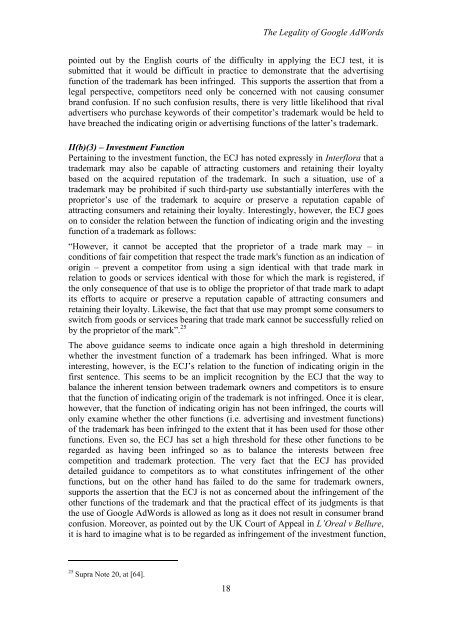Open UKLSR Volume 1(2) - Uklsa
Open UKLSR Volume 1(2) - Uklsa
Open UKLSR Volume 1(2) - Uklsa
You also want an ePaper? Increase the reach of your titles
YUMPU automatically turns print PDFs into web optimized ePapers that Google loves.
18<br />
The Legality of Google AdWords<br />
pointed out by the English courts of the difficulty in applying the ECJ test, it is<br />
submitted that it would be difficult in practice to demonstrate that the advertising<br />
function of the trademark has been infringed. This supports the assertion that from a<br />
legal perspective, competitors need only be concerned with not causing consumer<br />
brand confusion. If no such confusion results, there is very little likelihood that rival<br />
advertisers who purchase keywords of their competitor’s trademark would be held to<br />
have breached the indicating origin or advertising functions of the latter’s trademark.<br />
II(b)(3) – Investment Function<br />
Pertaining to the investment function, the ECJ has noted expressly in Interflora that a<br />
trademark may also be capable of attracting customers and retaining their loyalty<br />
based on the acquired reputation of the trademark. In such a situation, use of a<br />
trademark may be prohibited if such third-party use substantially interferes with the<br />
proprietor’s use of the trademark to acquire or preserve a reputation capable of<br />
attracting consumers and retaining their loyalty. Interestingly, however, the ECJ goes<br />
on to consider the relation between the function of indicating origin and the investing<br />
function of a trademark as follows:<br />
“However, it cannot be accepted that the proprietor of a trade mark may – in<br />
conditions of fair competition that respect the trade mark's function as an indication of<br />
origin – prevent a competitor from using a sign identical with that trade mark in<br />
relation to goods or services identical with those for which the mark is registered, if<br />
the only consequence of that use is to oblige the proprietor of that trade mark to adapt<br />
its efforts to acquire or preserve a reputation capable of attracting consumers and<br />
retaining their loyalty. Likewise, the fact that that use may prompt some consumers to<br />
switch from goods or services bearing that trade mark cannot be successfully relied on<br />
by the proprietor of the mark”. 25<br />
The above guidance seems to indicate once again a high threshold in determining<br />
whether the investment function of a trademark has been infringed. What is more<br />
interesting, however, is the ECJ’s relation to the function of indicating origin in the<br />
first sentence. This seems to be an implicit recognition by the ECJ that the way to<br />
balance the inherent tension between trademark owners and competitors is to ensure<br />
that the function of indicating origin of the trademark is not infringed. Once it is clear,<br />
however, that the function of indicating origin has not been infringed, the courts will<br />
only examine whether the other functions (i.e. advertising and investment functions)<br />
of the trademark has been infringed to the extent that it has been used for those other<br />
functions. Even so, the ECJ has set a high threshold for these other functions to be<br />
regarded as having been infringed so as to balance the interests between free<br />
competition and trademark protection. The very fact that the ECJ has provided<br />
detailed guidance to competitors as to what constitutes infringement of the other<br />
functions, but on the other hand has failed to do the same for trademark owners,<br />
supports the assertion that the ECJ is not as concerned about the infringement of the<br />
other functions of the trademark and that the practical effect of its judgments is that<br />
the use of Google AdWords is allowed as long as it does not result in consumer brand<br />
confusion. Moreover, as pointed out by the UK Court of Appeal in L’Oreal v Bellure,<br />
it is hard to imagine what is to be regarded as infringement of the investment function,<br />
25 Supra Note 20, at [64].


